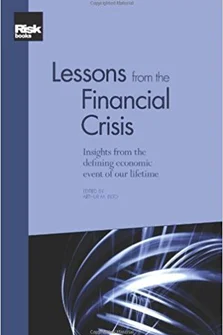Underwriting versus Economy: A New Approach to Decomposing Mortgage Losses
Ashish Das and Roger M Stein
Introduction to 'Lessons from the Financial Crisis'
The Credit Crunch of 2007: What Went Wrong? Why? What Lessons Can be Learned?
Underwriting versus Economy: A New Approach to Decomposing Mortgage Losses
The Shadow Banking System and Hyman Minsky’s Economic Journey
The Collapse of the Icelandic Banking System
The Quant Crunch Experience and the Future of Quantitative Investing
No Margin for Error: The Impact of the Credit Crisis on Derivatives Markets
The Re-Emergence of Distressed Exchanges in Corporate Restructurings
Modelling Systemic and Sovereign Risks
Measuring and Managing Risk in Innovative Financial Instruments
Forecasting Extreme Risk of Equity Portfolios with Fundamental Factors
Limits of Implied Credit Correlation Metrics Before and During the Crisis
Another view on the pricing of MBSs, CMOs and CDOs of ABS
Pricing of Credit Derivatives with and without Counterparty and Collateral Adjustments
A Practical Guide to Monte Carlo CVA
The Endogenous Dynamics of Markets: Price Impact, Feedback Loops and Instabilities
Market Panics: Correlation Dynamics, Dispersion and Tails
Financial Complexity and Systemic Stability in Trading Markets
The Martingale Theory of Bubbles: Implications for the Valuation of Derivatives and Detecting Bubbles
Managing through a Crisis: Practical Insights and Lessons Learned for Quantitatively Managed Equity Portfolios
Active Risk Management: A Credit Investor’s Perspective
Investment Strategy Returns: Volatility, Asymmetry, Fat Tails and the Nature of Alpha
Recent events in the mortgage market have led market participants and observers to discuss the role of underwriting standards in the 2007–9 market crisis. This chapter presents some stylised facts based on a series of ex post simulation experiments that were conducted using loan-by-loan data on 136 subprime mortgage pools underlying US residential mortgage-backed securities (RMBSs) issued between 2002 and 2007. The goal of these experiments is to provide some sense of the degree to which shifts in underwriting standards and the changing economic environment affect subsequent pool performance. In order to accomplish this decomposition, an instrument based on the transformation of a readily available Federal Reserve (hereafter simply referred to as “Fed”) series is used that exogenises underwriting explicitly. This exogeneity is particularly convenient in settings where underwriting standards and the future state of the economy are evolving in tandem, as it permits a separation of these two effects. An attractive feature of this measure is that it can be observed in real time, and thus may be useful for forecasting subsequent mortgage performance for newly originated mortgages before
Copyright Infopro Digital Limited. All rights reserved.
As outlined in our terms and conditions, https://www.infopro-digital.com/terms-and-conditions/subscriptions/ (point 2.4), printing is limited to a single copy.
If you would like to purchase additional rights please email info@risk.net
Copyright Infopro Digital Limited. All rights reserved.
You may share this content using our article tools. As outlined in our terms and conditions, https://www.infopro-digital.com/terms-and-conditions/subscriptions/ (clause 2.4), an Authorised User may only make one copy of the materials for their own personal use. You must also comply with the restrictions in clause 2.5.
If you would like to purchase additional rights please email info@risk.net







